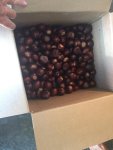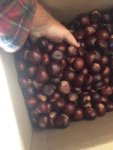Unlike apples, pears and peaches that were brought here, pawpaws have been in North America since glacial times. They fed the Indians who in addition to eating the fruit's sweet flesh, chewed the skin of the fruit to cure constipation. The skin and seeds are a natural diuretic (if you chew it) and an emetic (if you swallow it.) Suggestion - don't eat the skin.
Another interesting fact is that pawpaw is a powerful cancer fighter. Parts of the tree are processed into capsules. You can read more about it on this youtube link. Very interesting stuff.
https://www.youtube.com/watch?v=rt8oqjAkv9E
As the Lewis and Clark expedition moved West, they wrote that the pawpaws they found along creek banks saved them from starvation at one point.
They grow as far North as Michigan, Florida to the South, Virginia to the East and Missouri, Arkansas and Louisiana to the West. We also now have members of the North American Pawpaw Grower's association as far west as California, Colorado and in other countries.
They are Ohio's official state native fruit and are the only tropical fruit that grows wild in North America.
They taste like a very ripe banana and are from the custard apple family.
You can eat them right out of the skin or use the flesh in baking or cooking as a fat substitute. Use it where you might use eggs or shortening. Pawpaw is considered good fat like the avocado. They are low in calories and full of vitamins and minerals.
My family's favorites are pawpaw bread, just like banana bread, pawpaw mango salsa and pawpaw oatmeal raisin cookies.
At Ohio's Pawpaw Festival held each September (coinciding with harvest) there are vendors who make pawpaw beer, wine and everything you can think of.
The really cool thing about pawpaws is my parents and grandparents knew about them when they were younger and were pleased to see interest resurging. Oh the stories they told.
The downside is that like bananas, pawpaws have a limited shelf life. A good cold fridge can extend the life to around two weeks but any longer and you need to puree and freeze the flesh.
The seeds can and will produce new seedlings so long as they are never allowed to freeze or dry out. Storing them in moist medium like potting soil or sawdust in the bottom of the fridge at 40 degrees or lower (not allowing to freeze) will cause them to stratify and get them ready to plant in the spring.
There are five ways to produce supplemental income from pawpaws
1. Sell the seeds
2. Sell the trees
3. Sell the frozen pawpaw pulp
4. Sell scion wood (taken from trees with desirable characteristics, sweetness, disease resistance, predictable ripening month, etc)
5. Sell the fruit
We have chosen to concentrate on seedling production but do share our scion wood with the growers association. The mature trees are a beautiful pyramid shape and quite resilient after they are a few years old. Most of our trees were started in 7.5 to 8.8ph red clay soil which we have managed to bring down to about 6.5 to 7.0 through the application of organic material twice a year.
A pawpaw tree can produce fruit in 4-6 years for a native seedling. But grafting scion wood from a more vigorous or productive variety onto a seedling can accelerate that to as little as 3-4 years.
Here is a link to some other frequently asked questions. Hope this helps.
https://ohiopawpaw.com/pawpaw-faqs/





 collie
collie